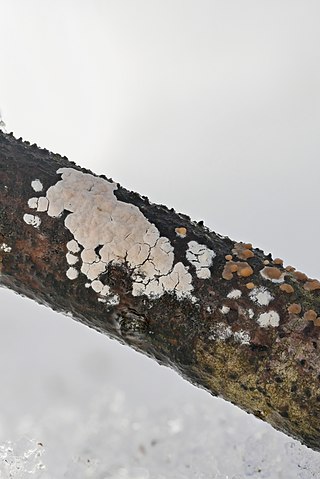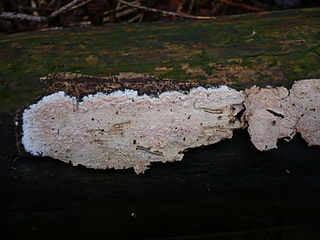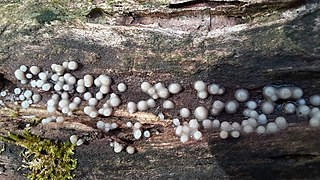
The Hymenochaetales are an order of fungi in the class Agaricomycetes. The order in its current sense is based on molecular research and not on any unifying morphological characteristics. According to one 2008 estimate, the Hymenochaetales contain around 600 species worldwide, mostly corticioid fungi and poroid fungi, but also including several clavarioid fungi and agarics. Species of economic importance include wood decay fungi in the genera Phellinus and Inonotus sensu lato, some of which may cause losses in forestry. Therapeutic properties are claimed for Inonotus obliquus ("chaga") and Phellinus linteus, both of which are now commercially marketed.

The Agaricomycetes are a class of fungi in the division Basidiomycota. The taxon is roughly identical to that defined for the Homobasidiomycetes by Hibbett & Thorn, with the inclusion of Auriculariales and Sebacinales. It includes not only mushroom-forming fungi, but also most species placed in the deprecated taxa Gasteromycetes and Homobasidiomycetes. Within the subdivision Agaricomycotina, which already excludes the smut and rust fungi, the Agaricomycetes can be further defined by the exclusion of the classes Tremellomycetes and Dacrymycetes, which are generally considered to be jelly fungi. However, a few former "jelly fungi", such as Auricularia, are classified in the Agaricomycetes. According to a 2008 estimate, Agaricomycetes include 17 orders, 100 families, 1147 genera, and about 21000 species. Modern molecular phylogenetic analyses have been since used to help define several new orders in the Agaricomycetes: Amylocorticiales, Jaapiales, Stereopsidales, and Lepidostromatales.

Corticium roseum is a species of fungus in the family Corticiaceae. Basidiocarps are effused, smooth, corticioid, and pink. The species has a wide, north and south temperate distribution and in Europe is typically found on dead, attached branches of Salix and Populus.
Corticium is a genus of fungi in the family Corticiaceae. Basidiocarps are effused, corticioid, smooth, and grow on dead wood. One species, C. silviae, is lichenicolous. The genus was formerly used in a very wide sense for almost any effused corticioid fungi.

Dentocorticium is a genus of six species of poroid fungi in the family Polyporaceae. The genus was revised in 2018, with several new species added and some older species transferred to other genera, based on phylogenetic analyses.

Sebacina is a genus of fungi in the family Sebacinaceae. Its species are mycorrhizal, forming a range of associations with trees and other plants. Basidiocarps are produced on soil and litter, sometimes partly encrusting stems of living plants. The fruit bodies are cartilaginous to rubbery-gelatinous and variously effused (corticioid) to coral-shaped (clavarioid). The genus has a cosmopolitan distribution.

The corticioid fungi are a group of fungi in the Basidiomycota typically having effused, smooth basidiocarps that are formed on the undersides of dead tree trunks or branches. They are sometimes colloquially called crust fungi or patch fungi. Originally such fungi were referred to the genus Corticium and subsequently to the family Corticiaceae, but it is now known that all corticioid species are not necessarily closely related. The fact that they look similar is an example of convergent evolution. Since they are often studied as a group, it is convenient to retain the informal (non-taxonomic) name of "corticioid fungi" and this term is frequently used in research papers and other texts.

The hydnoid fungi are a group of fungi in the Basidiomycota with basidiocarps producing spores on pendant, tooth-like or spine-like projections. They are colloquially called tooth fungi. Originally such fungi were referred to the genus Hydnum, but it is now known that not all hydnoid species are closely related.

The Ceratobasidiaceae are a family of fungi in the order Cantharellales. All species within the family have basidiocarps that are thin and effused. They have sometimes been included within the corticioid fungi or alternatively within the "heterobasidiomycetes". Species are saprotrophic, but some are also facultative plant pathogens or are associated with orchid mycorrhiza. Genera of economic importance include Ceratobasidium and Rhizoctonia, both of which contain plant pathogenic species causing diseases of commercial crops and turf grass.

Brunneocorticium is a genus of fungi which following DNA analysis has been placed in the family Marasmiaceae. The genus, described in 2007, contains two corticioid species and one species which does not seem to have any fruiting body.

The Punctulariaceae are a family of fungi in the order Corticiales. The family in its current sense is based on molecular research and contains just three genera of corticioid fungi.

Amylocorticiales is an order of fungi in the class Agaricomycetes. The order was circumscribed in 2010 to contain mostly resupinate (crust-like) forms that have been referred to genera Anomoporia, Amyloathelia, Amylocorticiellum, Amylocorticium, Amyloxenasma, Anomoloma, Athelia, Athelopsis, Ceraceomyces, Hypochniciellum, Leptosporomyces and Serpulomyces.

Helicogloea is a genus of fungi in the family Phleogenaceae. Basidiocarps are gelatinous, effused or pustular, and (microscopically) have unclamped hyphae and basidia that are auricularioid. Some species form asexual anamorphs producing conidia. The widespread genus contains more than 20 species.
Cerinomyces is a genus of fungi in the order Dacrymycetales. Species are saprotrophs and occur on dead wood. As originally conceived, the genus comprised species of the Dacrymycetes having effused, corticioid basidiocarps. Molecular research, based on cladistic analysis of DNA sequences, has however shown that this circumscription is not valid. As a result, the genus now contains some species having corticioid basidiocarps and some additional species with gelatinous, pustular basidiocarps. Around 30 species have been described worldwide.
Hypochniciellum is a genus of corticioid fungi in the family Amylocorticiaceae. Species in the genus have white to cream-colored, resupinate fruit bodies. The hypha have clamp connections. The spores are roughly elliptical, yellowish, and smooth.

Botryobasidium is a genus of corticioid fungi belonging to the order Cantharellales. Basidiocarps are ephemeral and typically form thin, web-like, white to cream, effused patches on the underside of fallen branches, logs, and leaf litter. Several species form anamorphs producing chlamydospores. All species are wood- or litter-rotting saprotrophs and the genus has a worldwide distribution.
Radulotubus is a monotypic genus of corticioid or crust fungi in the family Radulomycetaceae containing the single resupinate species Radulotubus resupinatus. This species was found in Yunnan province, China and formally classified in 2016. The specimen was found growing on the fallen trunk of an angiosperm. It was originally placed in the family Pterulaceae and noted to be closesly related with Aphanobasidium and Radulomyces.
The Cerinomycetaceae are a family of fungi in the order Dacrymycetales. The family currently contains the single genus Cerinomyces which has a cosmopolitan distribution.
Oliveonia is a genus of fungi in the order Auriculariales. Species form thin, effused, corticioid basidiocarps with microscopically prominent cystidia and aseptate basidia producing basidiospores that give rise to secondary spores. All species are believed to be saprotrophic, most growing on dead wood. The genus was originally published by American mycologist L.S. Olive in 1957 as Heteromyces, but this is an illegitimate later homonym of the lichen genus Heteromyces Müll.Arg. (1889). The genus was renamed Oliveonia by Dutch mycologist M.A. Donk in 1958.
Bourdotigloea is a genus of fungi in the family Phleogenaceae. Basidiocarps are effused, waxy, and (microscopically) have unclamped hyphae, conspicuous cystidia, and basidia that are auricularioid. Some species were formerly referred to Helicogloea, but molecular research, based on cladistic analysis of DNA sequences, has shown that the two genera are distinct. Bourdotigloea currently contains 9 species. The genus is known from Europe and North America.












